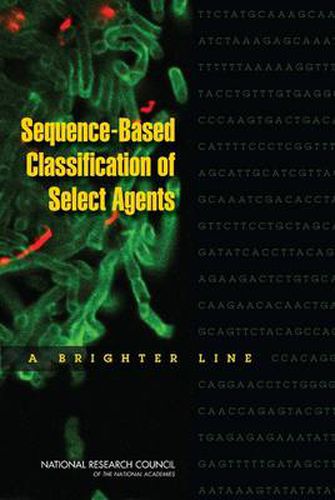Readings Newsletter
Become a Readings Member to make your shopping experience even easier.
Sign in or sign up for free!
You’re not far away from qualifying for FREE standard shipping within Australia
You’ve qualified for FREE standard shipping within Australia
The cart is loading…






Select Agents are defined in regulations through a list of names of particularly dangerous known bacteria, viruses, toxins, and fungi. However, natural variation and intentional genetic modification blur the boundaries of any discrete Select Agent list based on names. Access to technologies that can generate or ‘synthesize’ any DNA sequence is expanding, making it easier and less expensive for researchers, industry scientists, and amateur users to create organisms without needing to obtain samples of existing stocks or cultures. This has led to growing concerns that these DNA synthesis technologies might be used to synthesize Select Agents, modify such agents by introducing small changes to the genetic sequence, or create entirely new pathogens. Amid these concerns, the National Institutes of Health requested that the Research Council investigate the science and technology needed to replace the current Select Agent list with an oversight system that predicts if a DNA sequence could be used to produce an organism that should be regulated as a Select Agent. A DNA sequence-based system to better define when a pathogen or toxin is subject to Select Agent regulations could be developed. This could be coupled with a ‘yellow flag’ system that would recognize requests to synthesize suspicious sequences and serve as a reference to anyone with relevant questions, allowing for appropriate follow-up. Sequence-Based Classification of Select Agents finds that replacing the current list of Select Agents with a system that could predict if fragments of DNA sequences could be used to produce novel pathogens with Select Agent characteristics is not feasible. However, it emphasized that for the foreseeable future, any threat from synthetic biology and synthetic genomics is far more likely to come from assembling known Select Agents, or modifications of them, rather than construction of previously unknown agents. Therefore, the book recommends modernizing the regulations to define Select Agents in terms of their gene sequences, not by their names, and called this sequence-based classification. –Publisher’s description.
$9.00 standard shipping within Australia
FREE standard shipping within Australia for orders over $100.00
Express & International shipping calculated at checkout
Select Agents are defined in regulations through a list of names of particularly dangerous known bacteria, viruses, toxins, and fungi. However, natural variation and intentional genetic modification blur the boundaries of any discrete Select Agent list based on names. Access to technologies that can generate or ‘synthesize’ any DNA sequence is expanding, making it easier and less expensive for researchers, industry scientists, and amateur users to create organisms without needing to obtain samples of existing stocks or cultures. This has led to growing concerns that these DNA synthesis technologies might be used to synthesize Select Agents, modify such agents by introducing small changes to the genetic sequence, or create entirely new pathogens. Amid these concerns, the National Institutes of Health requested that the Research Council investigate the science and technology needed to replace the current Select Agent list with an oversight system that predicts if a DNA sequence could be used to produce an organism that should be regulated as a Select Agent. A DNA sequence-based system to better define when a pathogen or toxin is subject to Select Agent regulations could be developed. This could be coupled with a ‘yellow flag’ system that would recognize requests to synthesize suspicious sequences and serve as a reference to anyone with relevant questions, allowing for appropriate follow-up. Sequence-Based Classification of Select Agents finds that replacing the current list of Select Agents with a system that could predict if fragments of DNA sequences could be used to produce novel pathogens with Select Agent characteristics is not feasible. However, it emphasized that for the foreseeable future, any threat from synthetic biology and synthetic genomics is far more likely to come from assembling known Select Agents, or modifications of them, rather than construction of previously unknown agents. Therefore, the book recommends modernizing the regulations to define Select Agents in terms of their gene sequences, not by their names, and called this sequence-based classification. –Publisher’s description.